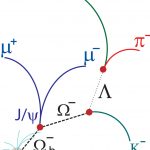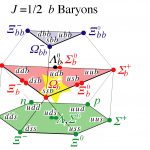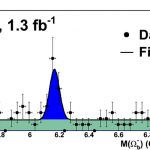Batavia, Ill. – Physicists of the DZero experiment at the U.S. Department of Energy’s Fermi National Accelerator Laboratory have discovered a new particle made of three quarks, the Omega-sub-b (Ωb). The particle contains two strange quarks and a bottom quark (s-s-b). It is an exotic relative of the much more common proton and weighs about six times the proton mass.
The discovery of the doubly strange particle brings scientists a step closer to understanding exactly how quarks form matter and to completing the “periodic table of baryons.” Baryons (derived from the Greek word “barys,” meaning “heavy”) are particles that contain three quarks, the basic building blocks of matter. The proton comprises two up quarks and a down quark (u-u-d).
Combing through almost 100 trillion collision events produced by the Tevatron particle collider at Fermilab, the DZero collaboration found 18 incidents in which the particles emerging from a proton-antiproton collision revealed the distinctive signature of the Omega-sub-b. Once produced, the Omega-sub-b travels about a millimeter before it disintegrates into lighter particles. Its decay, mediated by the weak force, occurs in about a trillionth of a second.
Theorists predicted the mass of the Omega-sub-b baryon to be in the range of 5.9 to 6.1 GeV/c2. The DZero collaboration measured its mass to be 6.165 ± 0.016 GeV/c2. The particle has the same electric charge as an electron and has spin J=1/2.
The Omega-sub-b is the latest and most exotic discovery of a new type of baryon containing a bottom quark at the Tevatron particle collider at Fermilab. Its discovery follows the observation of the Cascade-b-minus baryon (Ξb-), first observed by the DZero experiment in 2007, and two types of Sigma-sub-b baryons (Σb), discovered by the CDF experiment at Fermilab in 2006.
“The observation of the doubly strange b baryon is yet another triumph of the quark model,” said DZero cospokesperson Dmitri Denisov, of Fermilab. “Our measurement of its mass, production and decay properties will help to better understand the strong force that binds quarks together.”
According to the quark model, invented in 1961 by theorists Murray Gell-Mann and Yuval Ne’eman as well as George Zweig, the four quarks up, down, strange and bottom can be arranged to form 20 different spin-1/2 baryons. Scientists now have observed 13 of these combinations.
“The measurement of the mass of the Omega-sub-b provides a great test of computer calculations using lattice quantum chromodynamics,” said Fermilab theorist Andreas Kronfeld. “The discovery of this particle is an example of all the wonderful results pouring out of accelerator laboratories over the past few years.”
The Omega-sub-b is a relative of the famous and “even stranger” Omega-minus, which is made of three strange quarks (s-s-s).
“After the discovery of the Omega-minus, people started to accept that quarks really exist,” said DZero co-spokesperson Darien Wood, of Northeastern University. “Its discovery, made with a bubble chamber at Brookhaven National Laboratory in 1964, is the textbook example of the predictive power of the quark model.”
The DZero collaboration submitted a paper that summarizes the details of its discovery to the journal Physical Review Letters. It is available online at: http://www-d0.fnal.gov/Run2Physics/WWW/results/final/B/B08G/
DZero is an international experiment of about 600 physicists from 90 institutions in 18 countries. It is supported by the U.S. Department of Energy, the National Science Foundation and a number of international funding agencies. Fermilab is a national laboratory funded by the Office of Science of the U.S. Department of Energy, operated under contract by Fermi Research Alliance, LLC.
- Six quarks–up, down, strange, charm, bottom and top–are the building blocks of matter. Protons and neutrons are made of up and down quarks, held together by the strong nuclear force. The DZero experiment has discovered the Omega-sub-b particle, which contains two strange quarks (s) and one bottom quark (b).
- Once produced, the decay of the Omega-sub-b (Ωb) proceeds like fireworks. The particle travels about a millimeter before it disintegrates into two intermediate particles called J/Psi (J/ψ) and Omega-minus (Ω-). The J/Psi then promptly decays into a pair of muons. The Omega-minus baryon, on the other hand, can travel several centimeters before decaying into yet another unstable particle called a Lambda (Λ) baryon along with a long-lived particle called kaon (K). The Lambda baryon, which has no electric charge, also can travel several centimeters prior to decaying into a proton (p) and a pion (π). (Credit: DZero collaboration)
- Baryons are particles made of three quarks. The quark model predicts the combinations that exist with either spin J=1/2 (this graphic) or spin J=3/2. The graphic shows the various three-quark combinations with J=1/2 that are possible using the three lightest quarks–up, down and strange–and the bottom quark. The DZero collaboration discovered the Omega-sub-b, highlighted in the graphic. There exist additional baryons involving the charm quark, which are not shown. The top quark, discovered at Fermilab in 1995, is too short-lived to become part of a baryon. (Credit: DZero collaboration)
- The DZero collaboration identified 18 events that have the distinctive signature of the expected decay products of the Omega-sub-b. The mass of the particle is 6.165 ± 0.016 GeV/c2. (Credit: DZero collaboration)
- The Fermilab accelerator complex accelerates protons and antiprotons close to the speed of light. Converting energy into mass, the Tevatron collider can produce particles that are heavier than the protons and antiprotons that are colliding. The Tevatron produces millions of proton-antiproton collisions per second, maximizing the chance for discovery. Two experiments, CDF and DZero, search for new types of particles emerging from the collisions.
- The DZero detector is about the size of a 3-story house. The detector surrounds the collision point and records the path, energy and charge of short-lived particles emerging from the collisions. Its subsystems record the “debris” emerging from high-energy proton-antiproton collisions, unveiling the forces governing the subatomic world. Tracing the particle tracks back to the center of the collision, scientists discover what processes take place at the core of proton-antiproton collisions.
- Some of the 600 scientists of the DZero collaboration in front of the DZero detector shortly before it began taking data in 2001.










